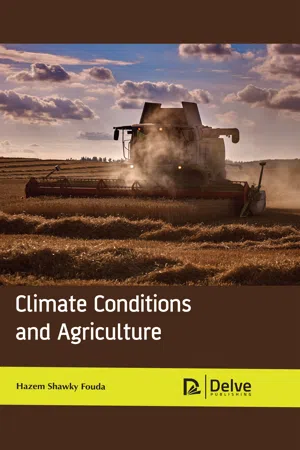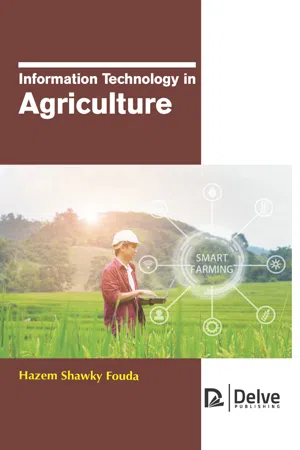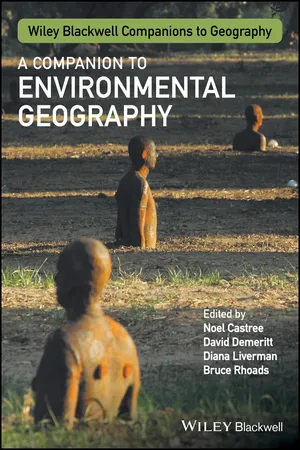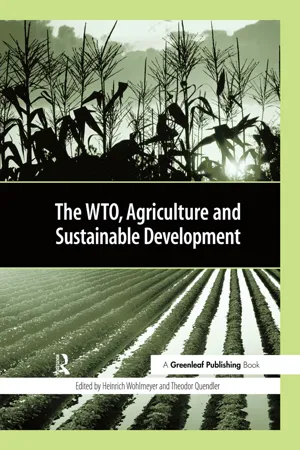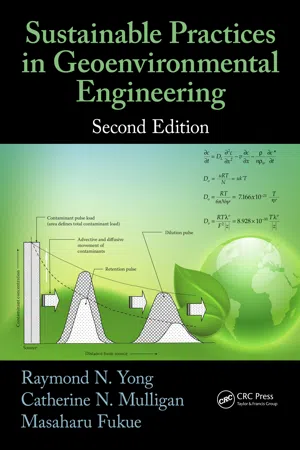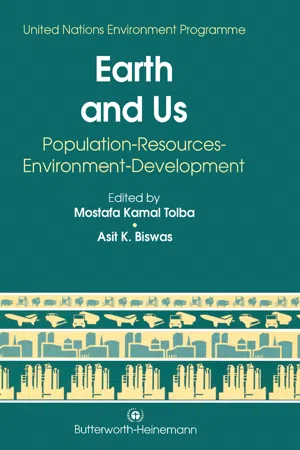Geography
Agriculture and Environment
Agriculture and the environment are interconnected as agricultural practices can have both positive and negative impacts on the environment. Positive impacts include carbon sequestration and biodiversity conservation, while negative impacts can include deforestation, water pollution, and soil degradation. Sustainable agricultural practices aim to minimize negative environmental impacts while maximizing the benefits for both agriculture and the environment.
Written by Perlego with AI-assistance
Related key terms
1 of 5
9 Key excerpts on "Agriculture and Environment"
- eBook - PDF
- Hazem Shawky Fouda(Author)
- 2019(Publication Date)
- Delve Publishing(Publisher)
Environmental Management in Relation to Agricultural Practices 9 CONTENTS 9.1. Introduction .................................................................................... 170 9.2. Nature Of Environmental Degradation ............................................ 171 9.3. Climatic Conditions On Mountainous Regions And Their Effects On Agricultural Production ............................................... 172 9.4. The Relationship Between Social Structure And Physical Environment ............................................ 177 9.5. The Need For A Healthy Environment In Agricultural Practices ........ 184 9.6. Public Awareness Of Environmental Problem ................................. 187 9.7. Key Industries That Pollute The Environment ................................... 189 9.8. Environmental Impacts Assessment In Agricultural Sector ............... 191 9.9. Methods Used In Environmental Impact Assessments ..................... 196 9.10. Environmental Protection .............................................................. 197 9.11. The Role Of International Communities In Management And Protection Of The Environment ............................................. 198 9.12. The Role Of Women In Conservation And Protection Of Environment ................................................................................. 201 Climate Conditions and Agriculture 170 9.1. INTRODUCTION Environment is defined as the totality of all those physical, chemical, biological and socio-economic factors that impinge on an individual, a population and a community. These factors include: • Human ecology • Public and occupational health • Safety • Pollution of the air, water, and land • Waste reduction • Management of unique habitats • Aesthetic and cultural preservation The environment is the integral natural-resources system, and it includes man and man’s manipulation of this system. - eBook - PDF
- Hazem Shawky Fouda(Author)
- 2019(Publication Date)
- Delve Publishing(Publisher)
Introduction to Agriculture: A Global Perspective 1 CONTENTS 1.1. Introduction ........................................................................................ 2 1.2. Agriculture as Landscapes of Food Production .................................... 4 1.3. The History of Agriculture ................................................................... 7 1.4. Types of Agriculture .......................................................................... 11 1.5. Agricultural Economics ..................................................................... 16 1.6. Agriculture And Economic Development .......................................... 17 1.7. Implications For Management of Agroecosystems ............................. 20 References ............................................................................................... 23 Information Technology in Agriculture 2 Agriculture is defined as the art and science of cultivating plants as well as livestock. In the growth of secondary human civilization, agriculture played a great role. The chapter initially deals with the concept of agriculture and its role in the supply of food. A brief history of agricultural practices has been discussed. Different kinds of agriculture such as nomadic herding, shifting cultivation, dairy farming, etc. are defined in the middle part of this chapter. At the later part of the chapter, agricultural economics has been explained. At the end of this chapter, implications for management of agroecosystems have been discussed in brief. 1.1. INTRODUCTION Agriculture is known as the human enterprise in which the natural ecosystems are used for the production of food, fuel and fiber. Considering the gradually increasing population, agriculture is an essential process to take place. Devoid of the improved production of edible biomass, simply there would not be sufficient amount of food to eat, as edible biomass characterizes the system of agriculture. - eBook - PDF
- R. Knowles, J. Wareing(Authors)
- 2014(Publication Date)
- Made Simple(Publisher)
PART ONE: THE STUDY OF ECONOMIC AND SOCIAL GEOGRAPHY CHAPTER ONE MAN AND ENVIRONMENT Geography is currently going through an exciting period in its development as new problems are identified and new methods of analysis are formulated. It is not easy to say precisely what geography is about because geographers often hold different views of the subject, and these views change from time to time, but this is not surprising since geographers are interested in a very wide range of problems and rapid advances are being made in the subject, as they are in all branches of knowledge. Because geography involves such a wide range of knowledge, the subject has been divided into two major areas of study. The first of these is physical geography, which is concerned with the physical environment of landforms, weather and climate, soils, and plants and animals (see Physical Geography Made Simple). The second is human geography, which is concerned with man's activities over the surface of the earth. In many ways this is a false distinction since the activities of man take place within the physical environment, and the physical environment is considerably affected by these activities, but the divi-sion is a useful one and in this book the physical environment will only be considered in relation to man. Human geography can be studied in two principal ways. First, the earth's surface can be studied part by part. This is the approach of regional geography, which seeks to understand the unique character of an area as produced by the interaction of human activity and the physical environment. Secondly, human activity over the earth's surface can be studied part by part. This is the approach of systematic geography, which isolates particular elements such as agriculture, industry or transport, and seeks to understand their spatial patterns and the processes which have produced them. - eBook - PDF
- Noel Castree, David Demeritt, Diana Liverman, Bruce Rhoads, Noel Castree, David Demeritt, Diana Liverman, Bruce Rhoads(Authors)
- 2009(Publication Date)
- Wiley-Blackwell(Publisher)
Environmental geography bleeds into other disciplines and fields that share its interest in ‘the geographical experiment’ (and human environment interactions). As noted above, we can formalise both points by drawing a distinction between the ‘discipline’ of environmental geography and a wider discourse that goes beyond it (cf. Gregory, 1995). This includes specialised fields like environmental sociology and environmental economics, as well as relatively young, purposefully cross-disciplinary fields like environmental science, ‘science studies’, ‘environmental studies’ and the already mentioned Earth Systems Science. Unsurprisingly, little of the work done in these and cognate fields uses the term ‘environmental geography’. But it does share the same commitment to investigating the social and non-human worlds in relation to one another (albeit ‘asymmetrically’ in many cases). On the social sciences side of all this, something of the scale and diversity of the discourse of environmental geography is captured well in Pretty et al.’s (2008) recent Hand- INTRODUCTION: MAKING SENSE OF ENVIRONMENTAL GEOGRAPHY 7 book of Environment and Society . (And on the science side, a series of reports by the US National Research Council on sustainability, human dimensions of global change and common property resources acknowledge the value of engaging the social sciences [www.nrc.edu].) While fairly definite, the borders that demarcate geography from these various other fields in the wider discourse of environmental geography are sufficiently porous that two-way traffic occurs quite readily, as many of our chapters bear out. In some cases, environmental geographers feel as much part of these other fields as their own. In other cases, they either draw upon the other fields to make their own distinctive contributions or else seek to shape them by ‘exporting’ their particular skills, perspectives and insights. - eBook - ePub
- Heinrich Wohlmeyer, Theodor Quendler(Authors)
- 2017(Publication Date)
- Routledge(Publisher)
Some of the above-mentioned arguments have already shown implicitly that agriculture produces ‘by-products’ during the production process for which farms are not paid. In economic theory benefits that occur as by-products during the economic production process and that are consumed by the public without rewarding the producer are called ‘positive externalities’. Such effects are not to be found exclusively in agriculture and are therefore not to be seen as an argument for giving this sector a special status. Still, it seems unambiguous and unanimously agreed that in the case of agriculture the extent of the effects and the number of beneficiaries seem to be somewhat remarkable.The relevant questions concerning agricultural production and its contributions to the protection and preservation of the environmental media—soil, water, air and biodiversity—will be dealt with in Chapter 13 . In what follows we deal with two other major benefits: the preservation of the cultural landscape, and risk management.Generally speaking, cultural landscapes are defined as landscapes shaped and maintained by human activity. Agricultural landscapes, which have been shaped by agricultural activity for centuries, constitute a major category of such landscapes. As well as the economic value of food production, the following values are typically derived from such landscapes:- Leisure value (contribution of the landscape to human health and human well-being)
- Aesthetic, cultural and historical values
- Biological and ecological values
These values are sustained by an agricultural production method adapted to the specific landscape and its environmental conditions. They are to be seen as by-products that cannot be decoupled from agricultural activity.Turning to risk management, it is important to recognise that prolonged agricultural production is synonymous with a minimisation of risk. It minimises the risk of food shortage arising from a cut in food imports—something that may become increasingly important in the context of a higher potential incidence of crop failures resulting from climatic change and severe weather events (e.g. floods and hurricanes). It also minimises the risk of losing know-how about agricultural production methods and specifically adapted cultivation techniques over time. Such knowledge, which in many cases is based on working experience, could be regained only in the long run. Its loss threatens food shortages if production, having once stopped, must be abruptly restarted. The risk of food shortage as a result of political unrest or logistical breakdowns tends, today, to be underestimated. The tendency is to centralise the logistics of food-supply operations and to decrease national buffer stocks, which increases national vulnerabilities to any supply problems. - No longer available |Learn more
- Raymond N. Yong, Catherine N. Mulligan, Masaharu Fukue(Authors)
- 2014(Publication Date)
- CRC Press(Publisher)
Soil, air and water quality, and threat management FIGURE 6.12 Summary of agricultural activities, their impacts, and minimization of the impacts. 202 Sustainable Practices in Geoenvironmental Engineering Modeling of the emissions based on C, N, and P mass balances is an effective method to compare manure management methods. However, soil conditions, climate, and other factors can significantly influence the results of the comparison. This approach is a clear example of minimization of the impact of agricultural practices shown in Figure 6.12. 6.6 Tools for Evaluation of Geoenviroment Impacts from Farming Stressor Sources 6.6.1 Agricultural Sustainability To avoid and/or mitigate risks and protect soil quality and geoenvironmental quality as a whole, we need to develop a methodology for evaluation of potential and existing risks to agricultural and geoenvironment sustainability as a result of agricultural activities. It has been estimated that 28% of soil degradation is due to faulty agricultural practices (Quendler and Reichert, 2002). There appears to be some significant room for improve-ment. One needs to (a) examine the impact of the farming practices on the quality of groundwater and other receiving waters, soil quality, and biodiversity; (b) seek methods to quantify the various kinds of emissions that take the form of stressors to the geoen-vironment; and (c) determine the fate and transport pathways of the harmful emissions (stressors). By including air, water, soil, and vegetation as part of the agroecosystem, one could seek measures in an integrated approach to (a) limit the harmful discharges and (b) curtail inefficient practices or emissions—as the first major step toward generation of sustainability. Some of these measures include (a) ecological footprint, (b) sustainable processing index (SPI), and (c) material intensity per service unit (MIPS) or land intensity per service unit (LIPS) (Quendler et al., 2002). - eBook - PDF
Earth and Us
Population – Resources – Environment – Development
- Mostafa Kamal Tolba, Asit K. Biswas(Authors)
- 2013(Publication Date)
- Butterworth-Heinemann(Publisher)
The characteristics of such an approach are: human equity, stability of production, maintenance of ecological processes and balances, and integration of 44 Environmental aspects of agricultural and rural development ecological, social, institutional and technical considerations. To achieve this objective, action is required on a number of fronts. Some of the activities will have a direct bearing on environment; others can have substantial indirect effects by influencing how farmers and fishermen manage their resources and production. These include pricing policies, subsidies, market infrastructure, export markets, cost of energy, level of investment in agriculture and political stability. Lest we become hopelessly enmeshed in the economic and political constraints, the environmental challenges to agriculture can be limited to six main areas: (1) Strengthening policies and institutions (2) Expanding technical training (3) Improving information dissemination and awareness building at local levels (4) Integrating traditional production systems with advanced technologies (5) Research and development (6) Technical assistance which meets the needs of the farmer Many countries have inadequate policies and institutions to address their environmental problems related to agriculture. In others, there is a lack of communication and coordination between natural resource management and agricultural production. This can be manifested in the form of farmers unwilling to produce crops beyond their immediate needs due to the low market prices set by the government, or of one government agency planting trees on a site that another agency intends to use for agricultural production. There are also instances of development in the upper part of a watershed adversely affecting activities in the lower reaches. - eBook - PDF
Human Geography
People, Place, and Culture
- Erin H. Fouberg, Alexander B. Nash, Alexander B. Murphy, Harm J. de Blij(Authors)
- 2015(Publication Date)
- Wiley(Publisher)
This leaves open the possibility of “surprises”— unanticipated responses by physical systems. The complexity and urgency of the environmental chal- lenge will tax the energies of the scientific and policy communi- ties for some time to come. Geography must be an essential part of any serious effort to grapple with these challenges. The major changes that are taking place have different origins and spatial expressions, and each results from a unique combination of physical and social processes. We cannot simply focus on system dynamics and generalized causal relationships. We must also consider emerging patterns of environmental change and how different actions have different impacts on the operation of general processes from place to place. Geography is not the backdrop to the changes taking place; it is at the very heart of the changes themselves. SUMMARY Geographers are actively engaged in studying human-environment relations. They point out that how we understand nature influences how we understand our relationship to it. Various approaches to understanding nature, including Marxist and cultural perspectives, have informed environmental movements and government policy over the last 150 years. In the present day, environmental activism takes many forms and operates across a variety of scales from small local-food movements to global activism addressing genetically modified foods and questions of environmental justice. What will the future be like? The opening field note suggests that some see the future taking place somewhere beyond Planet Earth. Many would agree with geographer Robert Kates, who foresees a “warmer, more crowded, more connected but more diverse world.” As we consider this prospect, we must acknowl- edge that global environmental changes illustrate the limits of our knowledge of the Earth. Many of today’s global environmental changes were not anticipated. - eBook - PDF
- Slariya, Mohinder Kumar(Authors)
- 2021(Publication Date)
- Biotech(Publisher)
These practices have a strong link to agriculture and many a times on an exclusive This ebook is exclusively for this university only. Cannot be resold/distributed. basis, meaning thereby that certain foods found in these regions are not easy to grow within the larger food production system. All of us involved with the subject of agriculture may like to stop for a moment and think what these linkages mean to our pursuit, and reorient our efforts as needed. The complexity of food challenges being faced has thinkers baffled, largely reflecting through realignment of research and extension orientation the world over. We in our country lack the motivation to yet understand that these complexities will impact us more than other countries given our population pressure and resistance to change. The former is a well known phenomenon and the latter draws its qualifications from our hangover of the green revolution days that has influenced central thinking even for regions and areas that did not form part of the mid-60’s initiated thrust. Areas that have been beneficiaries of the green revolution are needing to think more seriously about the cascading impact of their involvement, while those not having benefited on account of initial exclusion may feel more fortunate given the state of agriculture in regions where unsustainable intensification efforts have been pursued. Hill states face unique challenges in terms of remoteness and their special geographical and food needs. They are also made to bear the skewed burden of upholding the cause of the environment translated exclusively in terms of keeping catchment intact by increasing area under forests; as if they are solely responsible to compensate for the problems created by all. Notwithstanding historical evolution of people- environment relationships, ecological elements in these regions have to undergo severe scrutiny and are kept under a more severe watch compared to other inhabited regions.
Index pages curate the most relevant extracts from our library of academic textbooks. They’ve been created using an in-house natural language model (NLM), each adding context and meaning to key research topics.
